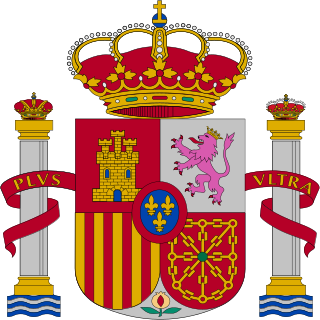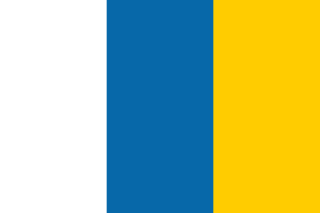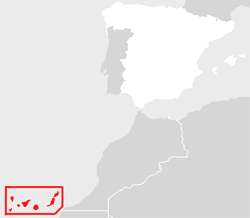
The autonomous communities are the first-level administrative divisions of Spain, created in accordance with the Spanish Constitution of 1978, with the aim of guaranteeing limited autonomy to the nationalities and regions that make up Spain.

The Senyera is a vexillological symbol based on the coat of arms of the Crown of Aragon, which consists of four red stripes on a yellow field. This coat of arms, often called bars of Aragon, or simply "the four bars", historically represented the King of the Crown of Aragon.

Spain is a diverse country integrated by contrasting entities with varying economic and social structures, languages, and historical, political and cultural traditions. The Spanish constitution responds ambiguously to the claims of historic nationalities while proclaiming a common and indivisible homeland of all Spaniards.

The flag of the Autonomous Community of the Canary Islands is a vertical tricolour of three equal bands of white, blue, and yellow. The state flag includes the coat of arms of the Canary Islands in the central band; the civil flag omits this. The designs were made official by the Statute of Autonomy of the Canarian Autonomous Community on 16 August 1982.

The flag of the Valencian Community and of the city of Valencia, known as Reial Senyera, is the traditional Senyera, composed of four red bars on a yellow background, crowned with a blue strip party per pale next to the hoist. It was adopted on 1 July 1982.

The 2011 Balearic regional election was held on Sunday, 22 May 2011, to elect the 8th Parliament of the autonomous community of the Balearic Islands. All 59 seats in the Parliament were up for election. The election was held simultaneously with regional elections in twelve other autonomous communities and local elections all throughout Spain.

The 1983 Balearic regional election was held on Sunday, 8 May 1983, to elect the 1st Parliament of the autonomous community of the Balearic Islands. All 54 seats in the Parliament were up for election. The election was held simultaneously with regional elections in twelve other autonomous communities and local elections all throughout Spain.

The 1987 Balearic regional election was held on Wednesday, 10 June 1987, to elect the 2nd Parliament of the autonomous community of the Balearic Islands. All 59 seats in the Parliament were up for election. The election was held simultaneously with regional elections in twelve other autonomous communities and local elections all throughout Spain, as well as the 1987 European Parliament election.

The 1991 Balearic regional election was held on Sunday, 26 May 1991, to elect the 3rd Parliament of the autonomous community of the Balearic Islands. All 59 seats in the Parliament were up for election. The election was held simultaneously with regional elections in twelve other autonomous communities and local elections all throughout Spain.

The 1995 Balearic regional election was held on Sunday, 28 May 1995, to elect the 4th Parliament of the autonomous community of the Balearic Islands. All 59 seats in the Parliament were up for election. The election was held simultaneously with regional elections in twelve other autonomous communities and local elections all throughout Spain.

The 1999 Balearic regional election was held on Sunday, 13 June 1999, to elect the 5th Parliament of the autonomous community of the Balearic Islands. All 59 seats in the Parliament were up for election. The election was held simultaneously with regional elections in twelve other autonomous communities and local elections all throughout Spain, as well as the 1999 European Parliament election.

The 2003 Balearic regional election was held on Sunday, 25 May 2003, to elect the 6th Parliament of the autonomous community of the Balearic Islands. All 59 seats in the Parliament were up for election. The election was held simultaneously with regional elections in twelve other autonomous communities and local elections all throughout Spain.

The 2007 Balearic regional election was held on Sunday, 27 May 2007, to elect the 7th Parliament of the autonomous community of the Balearic Islands. All 59 seats in the Parliament were up for election. The election was held simultaneously with regional elections in twelve other autonomous communities and local elections all throughout Spain.

Mallorca is one of the four constituencies represented in the Parliament of the Balearic Islands, the regional legislature of the Autonomous Community of the Balearic Islands. The constituency currently elects 33 deputies. Its boundaries correspond to those of the island of Mallorca. The electoral system uses the D'Hondt method and a closed-list proportional representation, with a minimum threshold of five percent.

The flag of Castilla–La Mancha is one of the representative symbols of the Autonomous Community of Castilla–La Mancha, in Spain, defined by its Statute of Autonomy.

The coat of arms of the Castilla–La Mancha is described in the Spanish Law 1 of 30 June 1983, the Law of the coat of arms of Castilla-La Mancha Region and further regulated by Decree 132 of 5 July 1983, approving the official design of the coat of arms of Castilla-La Mancha and Decree 115 of 12 November 1985, supplementing Decree 132/1983.

The coat of arms of the Region of Murcia is described in the article 4 of the Spanish Organic Law 4 of 9 June 1982, the Statute of Autonomy of the Region of Murcia and further regulated by Decree 34 of 8 June 1983, approving the official design and use of the coat of arms of the Region of Murcia.
There is a variety of Vernacular languages spoken in Spain. Spanish, the official language in the entire country, is the predominant native language in almost all of the autonomous communities in Spain. Six of the seventeen autonomous communities in Spain have other co-official languages in addition to Spanish. Bilingualism in different degrees and in distinct communicative situations between Spanish and another language is a habitual practice for many of the Spanish people who reside in one of these autonomous communities.

The Day of the Canary Islands is celebrated annually on 30 May. It is a public holiday in the Spanish autonomous community of the Canary Islands.

The next Balearic regional election will be held no later than Sunday, 27 June 2027, to elect the 12th Parliament of the autonomous community of the Balearic Islands. All 59 seats in the Parliament will be up for election. If customary practice is maintained, the election will be held on Sunday, 23 May 2027, simultaneously with regional elections in at least seven other autonomous communities and local elections all throughout Spain.



















